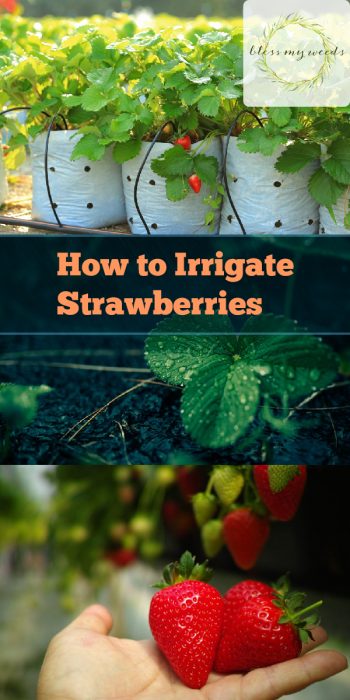
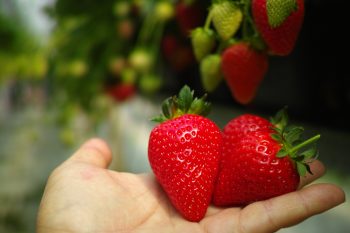
To grow the largest, best-tasting fruits, you need to know how to irrigate strawberries. Strawberries are a favorite of many gardeners, and for good reason. Homegrown strawberries yield delicious fruits, perfect for eating and making jam, if cared for right.
Most strawberries are perennials, meaning they come back from year to year without having to plant new seedlings. For more on care of strawberries, see our post on avoiding the most common strawberry-growing mistakes.
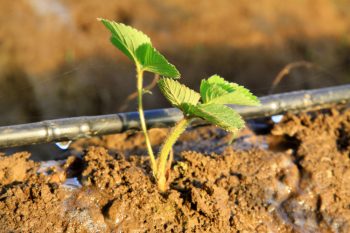
One of the trickiest things about growing strawberries is their watering needs. Strawberries need lots of water, but not so much water that the soil stays soggy. The thing that makes it tricky is that when you irrigate strawberries, water should not soak the leaves or the fruit. Wet leaves and fruit have a tendency to rot, so watering only around the base of the stems is the best way to irrigate strawberries.
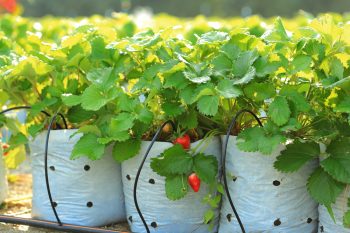
One of the ways to irrigate strawberries is with drip lines. A drip line is a water-saving irrigation system. Through a set of tubes and pipe valves, drip lines put water directly at the roots of the strawberry plants. Drip lines were originally designed for use in greenhouses and nurseries. They are very efficient because they deposit the water right at the roots, without soaking the rest of the plant’s tender leaves and berries.
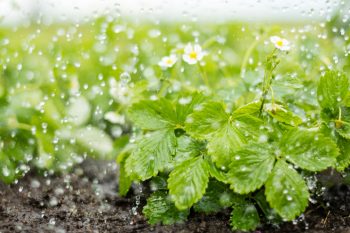
If you have a large strawberry patch, drip line watering is probably the easiest way to irrigate strawberries. However, if you have a small patch or a collection of potted strawberry plants, you can use direct-point irrigation. This essentially involves using a garden hose set on low. Hold or lay the hose on the soil at the base of each plant so that water doesn’t soak the plants.
Drip tape is another option to irrigate strawberries. Drip tape is a thin tube with tiny holes spaced along its length where water flows directly to the base of your plants. It connects to your garden hose and is best used to irrigate straight rows of strawberry plants.
No matter which of these methods you choose to irrigate strawberries, you will achieve effective watering that leads to sweet, juicy fruits to enjoy spring and summer!

Hi Kasi,
I have a question about the picture of the strawberry plants in white fabric pots. Are those your plants? Have you grown strawberries in fabric pots? Those look like two plants in a one gallon pot, possibly more. I am beginning a home strawberry garden all in containers and have a hodge-podge so far of homes for them—one GreenStalk 5 tier, three elevated Groundwork metal rolling planters from TSC, a small Vegpod, 2 Mr. Stackys. I am adding three Mobile Green Walls over the next week or so. I have a lot of trees in my yard and try to move the berries into the sun and move them under the carport to get them out of the rain to keep them from getting watered too much from above. I’m looking for containers that can be mobile (I could leave them on a cart) and that people have had success with growing strawberries.
I have a second question. I bought ten hanging baskets from a local nursery with strawberry plants about a month ago. Originally, I was going to replant the individual berry plants that were packed in the hanging baskets, but my stepmom encouraged me to leave them as they were. I learned about spider mites from these baskets, and now, I’m learning about gray mold. I’m treating with neem oil for both and cutting off all diseased berries, stems, and leaves. I wanted to ask you about your opinion on transplanting to give each of the plants more space. In a 10inch hanging pot, there are 8 or more Quinault or Eversweet berry plants. I would hope they would have a better chance at thriving and producing more, better berries, if they had more space and better soil for growing. I appreciate any advice you can share.
Thank you,
Ashley
Hi Ashley,
First of all, good for you for growing strawberries. I am always excited to help anyone who is giving gardening a try. Let me try and address your questions one at a time.
Strawberry plants do fine in fabric containers. Fabric containers do well because they help drain water quickly. Strawberries like moisture that is consistent and drains well. Otherwise, rot will occur.
Strawberry plants, just like most of us, need a little elbow room. Overcrowding them can cause issues. There is a good rule of thumb to follow when growing these berries. Usually 3 varieties per square foot soil is the max. When the plants are overcrowded, they will not produce as much fruit. Transplanting them sounds like a good plan. Should you decide to do so, do it when temps are cooler as in the morning or evening. If your new container has been in the sun, spray it with water to bring the temperature down. It would be best to store it in a cool dry place before using it to house the the transplants. One disadvantage to containers compared to growing plants in the ground is the insulation factor. Containers expose the roots to higher temperatures especially if they are dark in color and hold heat. This can affect the production of berries. Keep your soil damp. Dry or soggy soil is not good.
When transplanting to a larger container, make sure the soil you add is full of organic matter. Potting soils usually offer this and as a bonus you can add an inch at the top of fresh compost.
Hope this helps you. Thanks for reaching out and please let me know how it goes. Good luck!